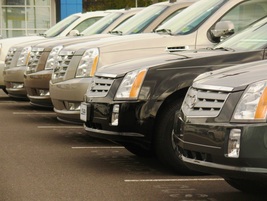 photo copyright Brian E. Faulkner
photo copyright Brian E. Faulkner This morning’s gleanings were more compelling than most. One headline that caught my eye was atop a small ad for a 2007 Cadillac Deville DTS. It read, “Not a misprint!” and fairly screamed “Look at me!” The sparely worded copy described a low mileage car “that hardly ever had been driven in the rain.” I was tempted to call and snap that one up, and if there weren’t already two perfectly serviceable cars in my garage, I might have.
The other ad that got my attention had an equally arresting headline: “My wife’s car.” Whoa! -- got to be a story here! The text described a “Torch Red” 2002 Mustang convertible with only 27,000 miles. My mind raced. Here’s grist for that novel I never got around to writing. I wanted to call just to get the dirt. Was the husband a control freak who only let his wife drive to the grocery store and kept close track of her mileage? Did she sneak the Mustang out for a top-down fling every now and then, hair flowing in the breeze, casting inhibitions to the wind while hubby was at work? Or were the two of them total lovebirds who only drove the Mustang on Sunday picnics? The truth probably was far more mundane than any of my coffee-fueled scenarios, but reading that ad got my morning off to a good start and also got me thinking about why one ad works better than another.
When I was doing dealer advertising, I advised my client about two important success points. First, an ad has to grab the reader’s eye, which has to do with arresting headlines (see above), strategic use of white space and other characteristics of good graphic design -- get people's attention and then tell them why they should want to do business with you (like the two classified ads that "sold" the Cadillac and the Mustang to their readers). That's the second point: it is the dealer’s responsibility to describe, or "position" their business in such a way that more people want to buy from them – regardless of the brands they may sell. My client got the first idea readily enough, and our ads (newspaper and radio) always stood out. But they never truly got comfortable with that second idea, the one that would have done them the most good over the long run, and eventually that was my undoing. We'd make a little progress and then they'd retreat to their "price" comfort zone. After a while, I think they just got tired of hearing me talk about “positioning” and bought into a your-name-here campaign that used a wildly humorous theme to attract attention but failed to communicate their unique story – which had several compelling strong points.
It’s so easy (and so lazy) to sell on price, which is why so many retailers do it. And since lots of them do it, it can seem like the right thing to do. Then, like lemmings, they all follow Pied Piper Price into the sea of wasted ad dollars.
A friend of mine who has a piano store gets it, and the piano business may be even worse than the car business when it comes to hammering the public with sale after sale. He has one sale a year and one sale only, which is incredibly successful. The rest of the year – with next to no advertising, he does a consistently good business based on his enduring reputation for integrity, service and impeccable piano prep (an important selling point for serious players). So qualified prospects think of him first when they want to buy a high end piano, leaving his competitors to beat each other’s brains out about price, an all too common occurrence in the piano business that can result in diminished profits and a weakened market.
Takeaway: Resist the urge to sell on price, set your business apart and you won't find yourself drowning in a sea of sameness.

 RSS Feed
RSS Feed